Understanding Modern Automotive Lifting Solutions
Car scissor lifts represent essential equipment in today's automotive industry, serving both professional mechanics and enthusiast home garages. These sophisticated lifting mechanisms utilize a unique folding support system that raises vehicles through interconnected crossing braces, providing stable and secure elevation for maintenance and repairs. The distinctive X-pattern movement has made car scissor lifts increasingly popular due to their space efficiency and reliable performance.
The automotive service industry has witnessed remarkable evolution in lifting technology, with car scissor lifts emerging as a cornerstone of efficient vehicle maintenance. These versatile tools offer precise elevation control and robust safety features, making them indispensable for everything from routine oil changes to complex undercarriage work.
Professional-Grade Car Scissor Lift Categories
Full-Size Commercial Scissor Lifts
Commercial-grade car scissor lifts stand as the backbone of professional automotive shops. These heavy-duty systems typically feature weight capacities ranging from 6,000 to 12,000 pounds, accommodating everything from compact cars to light commercial vehicles. The robust construction includes reinforced steel components and industrial-grade hydraulic systems designed for continuous daily operation.
These professional units often incorporate advanced safety features such as automatic locking mechanisms, multiple synchronization points, and emergency descent controls. The lifting height usually extends to around six feet, providing comfortable working clearance for technicians performing comprehensive vehicle services.
Mid-Rise Scissor Lift Systems
Mid-rise car scissor lifts offer an excellent balance between capability and space efficiency. These models typically rise to heights between three and four feet, making them perfect for tire services, brake work, and body repairs. Their compact design allows for installation in areas where full-size lifts might not fit, while still maintaining impressive lifting capacities of 4,000 to 6,000 pounds.
The versatility of mid-rise systems makes them particularly popular in quick-service facilities and mobile repair operations. Many models feature portable designs with wheels for easy repositioning, though they can also be permanently installed when needed.

Specialized Application Scissor Lifts
Low-Profile Portable Units
Low-profile car scissor lifts address the unique challenges of working with vehicles having minimal ground clearance. These systems typically feature entry heights as low as three inches, allowing access under sports cars and modified vehicles. The compact design emphasizes portability without sacrificing stability, though lifting capacities usually range from 2,500 to 4,000 pounds.
Many low-profile units operate on standard power supplies and include built-in wheel casters for easy movement around the workshop. Their versatility makes them valuable additions to facilities handling a diverse range of vehicles.
Alignment Scissor Lift Platforms
Alignment-specific car scissor lifts incorporate specialized features for wheel alignment services. These systems typically include integrated turn plates, slip plates, and precise leveling capabilities. The platforms are engineered to maintain exact positioning throughout the lifting process, ensuring accurate alignment readings and adjustments.
These sophisticated units often feature extended runway lengths to accommodate various vehicle wheelbases and include built-in lighting systems for improved visibility during detailed alignment work.
Home Garage Solutions
DIY-Friendly Portable Lifts
The home mechanic market has embraced compact car scissor lifts designed specifically for residential use. These units typically offer lifting capacities between 1,500 and 3,000 pounds, suitable for most passenger vehicles. The emphasis lies on user-friendly operation, straightforward maintenance requirements, and storage efficiency when not in use.
Safety features include manual locking positions, non-slip lifting surfaces, and simplified controls. While these units may not match commercial models in capacity, they provide excellent value for enthusiasts performing routine maintenance and modifications.
Storage-Oriented Parking Lifts
Storage-focused car scissor lifts serve dual purposes in residential settings. These systems enable vehicle stacking in limited garage spaces while providing maintenance access when needed. The design typically emphasizes long-term stability and weather resistance, with many models offering powder-coated finishes and sealed hydraulic systems.
These units often include extended height options for maximum space utilization and feature automatic safety locks at multiple positions. The investment in such systems can effectively double available parking space while maintaining accessibility for vehicle care.
Frequently Asked Questions
What maintenance do car scissor lifts require?
Regular maintenance includes checking hydraulic fluid levels, inspecting wear points, lubricating moving components, and verifying safety lock operation. Professional units should undergo certified inspection annually, while home units benefit from quarterly basic maintenance checks.
How long do car scissor lifts typically last?
With proper maintenance and operation, commercial car scissor lifts can last 15-20 years or more. Home-use models typically provide 8-12 years of reliable service, though actual lifespan depends heavily on usage patterns and maintenance adherence.
What safety features should I look for in a car scissor lift?
Essential safety features include automatic locking mechanisms, overload protection, emergency descent controls, and non-slip lifting surfaces. Professional models should also include velocity fuses for hydraulic failure protection and multiple redundant safety systems.

